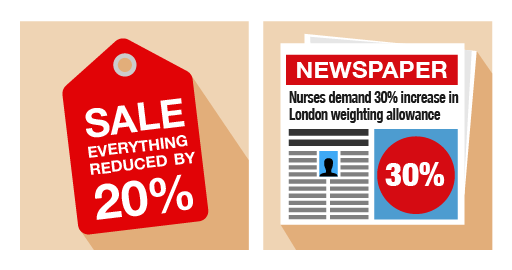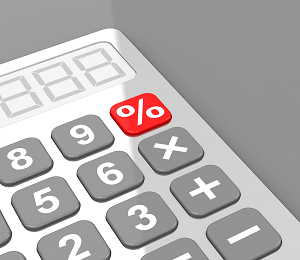5.1 Percentage increases and decreases
You’ll often see percentage increases and decreases in sales and pay rises.
Example: Anjali’s pay rise
Anjali earns £18,000 per year. She is given a 10% pay rise. How much does she now earn?
Method
In order to identify Anjali’s new salary, you need to find out what 10% () of £18,000 is. To do this, first you need to find out of £18,000:
18,000 ÷ 100 = 180
So of £18,000 is:
10 × 180 = 1,800
Anjali’s pay rise is £1,800, so her new salary is:
£18,000 + £1,800 = £19,800
Example: A sale at the furniture shop
A furniture shop reduces all of its prices by 20%. How much does a £300 double bed cost in the sale?
Method
In order to identify the new price of the double bed, you need to find out what 20% () of £300 is. To do this, first you need to find out of £300:
300 ÷ 100 = 3
So of £300 is:
20 × 3 = 60
The discount is £60, so the sale price of the double bed is:
£300 – £60 = £240
Use the examples above to help you with the following activity. Remember to check your answers once you have completed the questions.
Activity 16: Calculating percentage increases and decreases
- You buy a car for £9,000. Its value depreciates (decreases) by 25% annually. How much will the car be worth at the end of the first year?
- Since the start of the 21st century, the shares in the InstaBank have risen by 30%. If the price of one share was £10 in 2000, what is it worth now?
Answer
- In order to identify how much the value of the car will decrease by, you need to find out what 25% () of £9,000 is. To do this, first you need to find out of £9,000:
- 9,000 ÷ 100 = 90
- So of £9,000 is:
- 25 × 90 = 2,250
- The car’s value depreciates by £2,250 in the first year, so the value of the car at the end of the first year will be:
- £9,000 – £2,250 = £6,750
- It might be easier in this example to convert £10 into pence (£10 = 1,000p). In order to identify the new value of the share, you need to find out what 30% () of 1,000p is. To do this, first you need to find out of 1,000p:
- 1,000 ÷ 100 = 10
- So of 1,000p is:
- 30 × 10 = 300
- The share’s value has increased by 300p, or £3, since 2000, so the current value of the share is:
- £10 + £3 = £13
In this section you have learned how to calculate percentage increases and decreases. This will be useful when working out the value of a pay increase or how much an item will cost in a sale. You have also seen, and successfully used, two methods of calculating a percentage. There is one method that you haven’t been shown (and it’s probably the easiest!): using the percentage button on your calculator. The percentage button looks like this:
To successfully use it when calculating percentages you would enter the sum into your calculator as follows.
If you were asked to find 20% of 80, on your calculator you would input:
- 80 × 20%
This would give you the following answer:
- 80 × 20% = 16
This is by far the easiest way of calculating percentages when you have a calculator handy.
Summary
In this section you have learned how to solve problems using percentages, and how to calculate percentage increases and decreases.


